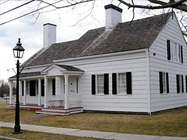- Home
- About
- Support
- History
- Town of Southampton Tour of Historic Places
- Our History
- The Foster-Meeker Heritage Center
- Area History
- The Baldt Anchor History
- Tuttle-Fordham Mill History
- Local Schools History
- Net Reel – Beach Lane Bridge – History
- Potunk Life Saving Station History
- The Castle & Theophilus Brouwer History
- The History of The Westhampton Beach Post Office
- Westhampton Beach Fire Department History
- Events
- Newsletters
- Visit
- Resources
- Contact Us

Eastport began as a fishing and farming community, the same as virtually all the villages on the south shore of Long Island, and even had several hotels and inns for “summer people.” But Eastport became unique in its open arms invitation to the duck industry. The famous “John Ducks Inn” was popular with both locals and New York City’s elite from the turn of the century through the 1940s. A young man by the name of Warren Washington Hallock began raising ducks at Brushy Neck in 1958. But it was not until after 1873 when Pekin ducks were introduced to the United States and Mr. Hallock started raising this new breed of duck that the business truly took off. Within several years his small duck farm had grown and additional farmers saw the potential and decided to try their hand at the duck business as well. Eventually these businesses became a real industry and Eastport came to be known as the “Duck Capital of the World”. The industry prospered for nearly 80 years until New York State established regulations to help curb the pollution from these farms, resulting in the closure of many smaller duck farms. A few of the larger farms prospered for some years, but today only one duck farm still operates locally on Long Island: the Corwin-Cresent Farm in Aquebogue. Curiously, although the bays appear cleaner now, when the duck farms were most abundant so were the clams, mussels and fish. Even eels and crabs were so abundant they were shipped by the barrel to New York City, yet today eels are practically nonexistent. Many historic homes remain from these early families. For more information on the history of Eastport and on these historic structures, follow this link to Southampton Town’s website, (read more…)
Quiogue
The hamlet of Quiogue lies between the villages of Quogue and Westhampton Beach and is bounded on the south by Quantuck Bay. Three hundred and fifty years ago Native Americans inhabited and named the area now called Quiogue, (pronounced Quī og) meaning “Little Quogue.” The name Quogue itself meant “a shaking marsh” and was derived from the Native American word Quaquanantuck.
Quiogue Walking Tour Guidebook
The first written use of the name Quiogue in Southampton Town records occurred in 1707. That entry related to the passing of land from Joseph Foster to his son, Daniel Foster. Excerpted from Historical Profile of the Hamlet of Quiogue by Ronald A. Michne Jr. (read more…)
The Quantuck Beach Club , originally organized by several prominent residents of Quiogue, was the subject of a tour sponsored by the Westhampton Beach Historical Society. History of the Quantuck Beach Club
Remsenburg & Speonk
As early as 1712 the meadows in Speonk were leased to cattle owners from Southampton. Early settlers of the area mainly came from Southampton, with farms being establishing here by the 1740s. The area developed slowly, until some further development occurred with the eastward extension of the Long Island Rail Road. By the 1880s, both boarding houses and duck farms thrived in Speonk. The name Speonk was inspired by a Native American word meaning high place. An 1897 Long Island Rail Road catalog listed Speonk, noting that that name “certainly sounds like the call of a frog.” Some residents pressed to change the name, signing a petition presented in February 1895 by the newly-installed minister, and after prominent resident Charles Remsen donated a new Presbyterian Church the southern portion of Speonk was renamed to Remsenburg. The Speonk/Remsenburg area initially developed as a farming community, but like many of the villages on the South Shore transitioned over the years to a tourism economy, with summer homes and resorts for the wealthy. This hamlet is especially lovely because there are no motels, restaurants, or businesses and it remains a quiet, peaceful residential community today, with its main road lined with white fences in front of stately homes both old and new. … Excerpted from Historical Profiles of Eastport Speonk/Remsenburg Westhampton prepared by Ronald A. Michne and Ronald A. Michne Jr. (read more…)
Remsenburg’s historic homes were the subject of a Westhampton Beach Historical Society House Tour, Remsenburg Walking Tour Guidebook
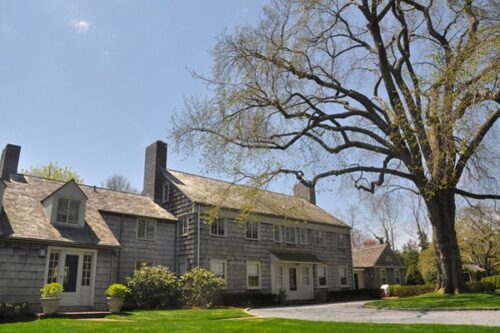
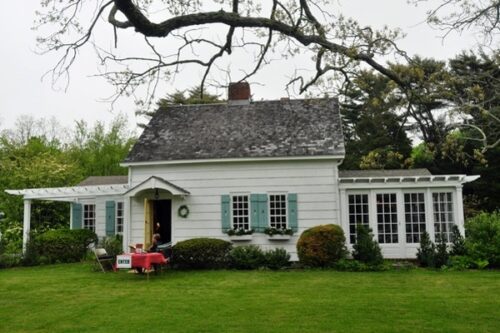
The Raynor Homestead built during the 1700s and 1800s, and The 1939-41 “Wit’s End” both located in Remsenburg were featured on our First Annual Historic House Tour. See details of these historic homes on our 2012 Events Page – Historic House Tour
Westhampton & Westhampton Beach
Not long after the English colonizers settled Southampton, they explored and soon made a few sparse settlements further west. Their first deeds were for lands east of Canoe Place (Shinnecock Canal) in 1640. There were conflicting ownership claims between the settlers and the local Shinnecock Indian Tribe, before the matter was settled in favor of Southampton Town by the governor in 1666. That deal was known as the Quogue Purchase and the Indians were reportedly paid 70 pounds in British money plus a few trinkets for the land. It covered land that now includes Westhampton Beach Village and surrounding parts of the Town, including unincorporated Westhampton. Indians called this portion of the purchased area Ketchaponack, or “place where large roots grow.”(Excerpted from Historical Profiles of Eastport Speonk/Remsenburg Westhampton prepared by by Ronald A. Michne and Ronald A. Michne Jr. (read more…)
Places of Special Interest: Three area structures are listed on the National Register of Historic Places…
Foster-Meeker House (added 2009 – National Register #09000656), 101 Mill Road, Westhampton Beach
Crowther House (added 1985 -National Register # 85000630), 97 Beach Lane, Westhampton Beach
Westhampton Beach Post Office (added 1989 – National Register # 88002446), Main Street, Westhampton Beach.
The History of The Westhampton Beach Post Office
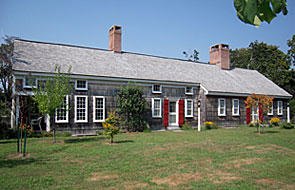
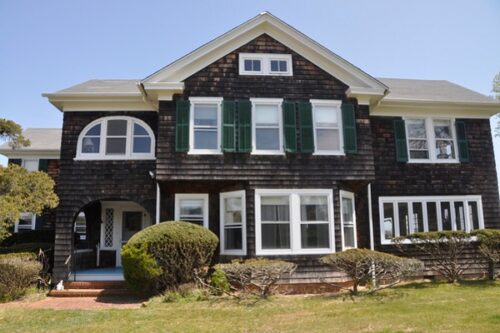
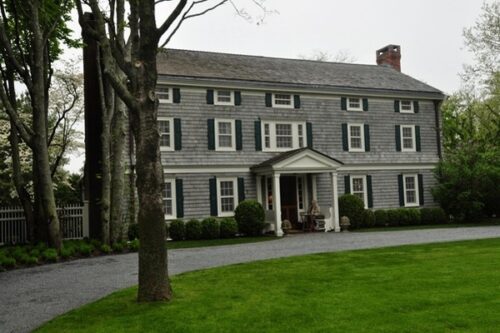
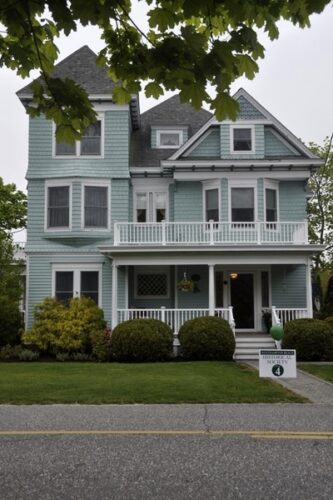
Howell Homestead
The Howell Homestead, originally constructed by Hezekiah Howell about 1727, is the oldest home in the Village of Westhampton Beach. A small timber-framed rear addition to the house may be the first house constructed on this property and is believed to date from slightly earlier. Hezekiah Howell (c.1677-1744), was the grandson of Edward Howell (1584-1655), a founder of Southampton Town who emigrated from England in the 1640s. The modest oak timber-frame Cape Cod-style house constructed by Mr. Howell is believed to be the first shelter built in Catchaponack (now Westhampton Beach) to house men who looked after the cattle that were grazed on these lands.
The Howell family owned and maintained the Homestead for over 200 years until 1942 when it was purchased by the William Gill family. In 1994 the home was purchased by Dr. and Mrs. Robert Berger. In 1998 the home changed hands again and was purchased by Mr and Mrs Jack L. Jones.
In 1997 a major fire broke out during renovation. Subsequent delays in stabilization and repairs resulted in additional damage to the structure. However in 1998, under Mr. Jones’ direction, a major restoration program was initiated to preserve and restore the historic portions of the house following the US Secretary of the Interior Standards for Historic Preservation. The result is the beautiful and comfortable home that exists today, perfectly in keeping with its historic origins and modern needs.
The 1727 Howell Homestead, The 1803 Griffing House & Tavern, The 1898 Wilcox Homestead, & The 1903 “Kemah” Estate were featured on our First Annual Historic House Tour. See details of these historic homes on our 2012 Events Page – Historic House Tour
Our Local Bays
The local waters along the South Shore have defined to a large degree, the lives of many families and the beginnings of our local history. Learn about maritime architecture, ranging from bay houses and bungalows to boatyards and hotels. See what is in your hometown. Listen to stories of hurricanes and rum runners. Learn how to document your community’s cultural resources. Add your own story to our memories page. And learn what baymen do for a living. All this and more!
Just click on South Shore Portal – share your thoughts with us and link to us!
West Hampton Dunes
This is the newest Village in our area, having been incorporated in 1993. Incorporation of this area was an attempt – a successful one – to have more control over its very existence. The area was practically obliterated in the Hurricane of 1938, and again in 1991 by the Halloween Nor’easter (also known as the Perfect Storm) and once again in 1992 during another Nor’easter. Each of those storms took a heavy toll on the beaches on the western end of Dune Road, leaving very little barrier beach – meaning very scanty protection for inland areas across Moriches Bay as well. What these homeowners were looking for and ultimately got, was a say in how the U.S. Army Corps of Engineers handled revitalizing the barrier beach. After Village incorporation and a subsequent successful lawsuit against the U.S. Army Corps of Engineers, rebuilding of the beach got underway. In 2007 the Westhampton Dunes beach was named one of the top restored beaches in the United States. The replenished beaches are now home to over 170 homes – nearly all built after the 1991 Nor’easter. To see the full story of this village that refused to be washed out to sea …watch The Incredible Journey at West Hampton Dunes Village website.
